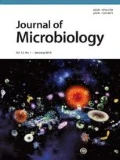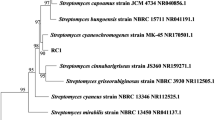Abstract
Quorum sensing (QS) has been a novel target for the treatment of infectious diseases. Here structural analogs of Pseudomonas aeruginosa autoinducer N-acyl homoserine lactone (AHL) were investigated for QS inhibitor (QSI) activity and a novel QSI was discovered, N-decanoyl-L-homoserine benzyl ester (C2). Virulence assays showed that C2 down-regulated total protease and elastase activities, as well as the production of rhamnolipid, that are controlled by QS in P. aeruginosa wild-type strain PAO1 without affecting growth. C2 was also shown to inhibit swarming motility of PAO1. Using a microdilution checkerboard method, we identified synergistic interactions between C2 and several antibiotics, tobramycin, gentamycin, cefepime, and meropenem. Data from real-time RT-PCR suggested that C2 inhibited the expression of lasR (29.67%), lasI (21.57%), rhlR (28.20%), and rhlI (29.03%).
Similar content being viewed by others
References
Antunes, L.C.M., Ferreira, R.B.R., Buckner, M.M.C., and Finlay, B.B. 2010. Quorum sensing in bacterial virulence. Microbiology-(UK) 156, 2271–2282.
Auvinet, A.L., Eignerova, B., Guy, A., Kotora, M., and Durand, T. 2009. Total synthesis of 4-F-3t-neuroprostane and its 4-epimer. Tetrahedron Lett. 50, 1498–1500.
Bjarnsholt, T. and Givskov, M. 2007. The role of quorum sensing in the pathogenicity of the cunning aggressor Pseudomonas aeruginosa. Anal. Bioanal. Chem. 387, 409–414.
Brint, J.M. and Ohman, D.E. 1995. Synthesis of multiple exoproducts in Pseudomonas aeruginosa is under the control of RhlR-RhlI, another set of regulators in strain PAO1 with homology to the autoinducer-responsive LuxR-LuxI family. J. Bacteriol. 177, 7155–7163.
CLSI. 2010. Performance standards for antimicrobial susceptibility testing; Twentieth Informational Supplement Clinical and Laboratory Standards Institute, Wayne, PA, USA.
Daniels, R., Vanderleyden, J., and Michiels, J. 2004. Quorum sensing and swarming migration in bacteria. FEMS Microbiol. Rev. 28, 289.
Doering, G., Conway, S.P., Heijerman, H.G.M., Hodson, M.E., Hoiby, N., Smyth, A., and Touw, D.J. 2000. Antibiotic therapy against Pseudomonas aeruginosa in cystic fibrosis: A European consensus. Eur. Respir. J. 16, 749–767.
Driscoll, J.A., Brody, S.L., and Kollef, M.H. 2007. The epidemiology, pathogenesis and treatment of Pseudomonas aeruginosa infections. Drugs 67, 351–368.
Ejim, L., Farha, M.A., Falconer, S.B., Wildenhain, J., Coombes, B.K., Tyers, M., Brown, E.D., and Wright, G.D. 2011. Combinations of antibiotics and nonantibiotic drugs enhance antimicrobial efficacy. Nat. Chem. Biol. 7, 348–350.
Geske, G.D., O’Neill, J.C., and Blackwell, H.E. 2008. Expanding dialogues: from natural autoinducers to non-natural analogues that modulate quorum sensing in Gram-negative bacteria. Chem. Soc. Rev. 37, 1432–1447.
Hancock, R.E.W. 1998. Resistance mechanisms in Pseudomonas aeruginosa and other nonfermentative Gram-negative bacteria. Clin. Infect. Dis. 27, S93–S99.
Hentzer, M., Wu, H., Andersen, J.B., Riedel, K., Rasmussen, T.B., Bagge, N., Kumar, N., Schembri, M.A., Song, Z.J., Kristoffersen, P., and et al. 2003. Attenuation of Pseudomonas aeruginosa virulence by quorum sensing inhibitors. Embo. J. 22, 3803–3815.
Holloway, B.W., Krishnapillai, V., and Morgan, A.F. 1979. Chromosomal genetics of Pseudomonas. Microbiol. Rev. 43, 73–102.
Ishida, T., Ikeda, T., Takiguchi, N., Kuroda, A., Ohtake, H., and Kato, J. 2007. Inhibition of quorum sensing in Pseudomonas aeruginosa by N-acyl cyclopentylamides. Appl. Environ. Microbiol. 73, 3183–3188.
Kiratisin, P., Tucker, K.D., and Passador, L. 2002. LasR, a transcriptional activator of Pseudomonas aeruginosa virulence genes, functions as a multimer. J. Bacteriol. 184, 4912–4919.
Koch, A.K., Kappeli, O., Fiechter, A., and Reiser, J. 1991. Hydrocarbon assimilation and biosurfactant production in Pseudomonas aeruginosa mutants. J. Bacteriol. 173, 4212–4219.
Kohler, T., Curty, L.K., Barja, F., van Delden, C., and Pechere, J.C. 2000. Swarming of Pseudomonas aeruginosa is dependent on cell-to-cell signaling and requires flagella and pili. J. Bacteriol. 182, 5990–5996.
Kristiansen, J.E., Hendricks, O., Delvin, T., Butterworth, T.S., Aagaard, L., Christensen, J.B., Flores, V.C., and Keyzer, H. 2007. Reversal of resistance in microorganisms by help of non-antibiotics. J. Antimicrob. Chemother. 59, 1271–1279.
Manefield, M., Rasmussen, T.B., Henzter, M., Andersen, J.B., Steinberg, P., Kjelleberg, S., and Givskov, M. 2002. Halogenated furanones inhibit quorum sensing through accelerated LuxR turnover. Microbiology-(UK) 148, 1119–1127.
Mattmann, M.E. and Blackwell, H.E. 2010. Small molecules that modulate quorum sensing and control virulence in Pseudomonas aeruginosa. J. Org. Chem. 75, 6737–6746.
Mazumdar, K., Dastidar, S.G., Park, J.H., and Dutta, N.K. 2009. The anti-inflammatory non-antibiotic helper compound diclofenac: an antibacterial drug target. Eur. J. Clin. Microbiol. Infect. Dis. 28, 881–891.
Ochsner, U.A., Koch, A., Fiechter, A., and Reiser, J. 1994. Isolation and characterization of a regulatory gene affecting rhamnolipid biosurfactant synthesis in Pseudomonas aeruginosa. J. Bacteriol. 176, 2044–2054.
Ochsner, U.A. and Reiser, J. 1995. Autoinducer-mediated regulation of rhamnolipid biosurfactant synthesis in Pseudomonas aeruginosa. Proc. Natl. Acad. Sci. USA 92, 6424–6428.
Odds, F.C. 2003. Synergy, antagonism, and what the chequerboard puts between them. J. Antimicrob. Chemother. 52, 1.
Passador, L., Cook, J.M., Gambello, M.J., Rust, L., and Iglewski, B.H. 1993. Expression of Pseudomonas aeruginosa virulence genes requires cell-to-cell communication. Science 260, 1127–1130.
Passador, L., Tucker, K.D., Guertin, K.R., Journet, M.P., Kende, A.S., and Iglewski, B.H. 1996. Functional analysis of the Pseudomonas aeruginosa autoinducer PAI. J. Bacteriol. 178, 5995–6000.
Pearson, J.P., Gray, K.M., Passador, L., Tucker, K.D., Eberhard, A., Iglewski, B.H., and Greenberg, E.P. 1994. Structure of the autoinducer required for expression of Pseudomonas aeruginosa virulence genes. Proc. Natl. Acad. Sci. USA 91, 197–201.
Pearson, J.P., Passador, L., Iglewski, B.H., and Greenberg, E.P. 1995. A second N-acylhomoserine lactone signal produced by Pseudomonas aeruginosa. Proc. Natl. Acad. Sci. USA 92, 1490–1494.
Pearson, J.P., Pesci, E.C., and Iglewski, B.H. 1997. Roles of Pseudomonas aeruginosa las and rhl quorum-sensing systems in control of elastase and rhamnolipid biosynthesis genes. J. Bacteriol. 179, 5756–5767.
Rand, K.H., Houck, H.J., Brown, P., and Bennett, D. 1993. Reproducibility of the microdilution checkerboard method for antibiotic synergy. Antimicrob. Agents Chemother. 37, 613–615.
Rashid, M.H. and Kornberg, A. 2000. Inorganic polyphosphate is needed for swimming, swarming, and twitching motilities of Pseudomonas aeruginosa. Proc. Natl. Acad. Sci. USA 97, 4885–4890.
Rasmussen, T.B., Bjarnsholt, T., Skindersoe, M.E., Hentzer, M., Kristoffersen, P., Kote, M., Nielsen, J., Eberl, L., and Givskov, M. 2005a. Screening for quorum-sensing inhibitors (QSI) by use of a novel genetic system, the QSI selector. J. Bacteriol. 187, 1799–1814.
Rasmussen, T.B., Skindersoe, M.E., Bjarnsholt, T., Phipps, R.K., Christensen, K.B., Jensen, P.O., Andersen, J.B., Koch, B., Larsen, T.O., Hentzer, M., Eberl, L., Hoiby, N., and Givskov, M. 2005b. Identity and effects of quorum-sensing inhibitors produced by Penicillium species. Microbiology-(UK) 151, 1325–1340.
Rudrappa, T. and Bais, H.P. 2008. Curcumin, a known phenolic from curcuma longa, attenuates the virulence of Pseudomonas aeruginosa PAO1 in whole plant and animal pathogenicity models. J. Agric. Food Chem. 56, 1955–1962.
Schuster, M., Lostroh, C.P., Ogi, T., and Greenberg, E.P. 2003. Identification, timing, and signal specificity of Pseudomonas aeruginosa quorum-controlled genes: a transcriptome analysis. J. Bacteriol. 185, 2066–2079.
Shim, J.Y., Kim, Y.A., Lee, E.H., Lee, Y.T., and Lee, H.S. 2008. Development of enzyme-linked immunosorbent assays for the organophosphorus insecticide EPN. J. Agric. Food Chem. 56, 11551–11559.
Smith, K.M., Bu, Y.G., and Suga, H. 2003a. Induction and inhibition of Pseudomonas aeruginosa quorum sensing by synthetic autoinducer analogs. Chem. Biol. 10, 81–89.
Smith, K.M., Bu, Y.G., and Suga, H. 2003b. Library screening for synthetic agonists and antagonists of a Pseudomonas aeruginosa autoinducer. Chem. Biol. 10, 563–571.
Tarkka, M.T., Sarniguet, A., and Frey-Klett, P. 2009. Inter-kingdom encounters: recent advances in molecular bacterium-fungus interactions. Curr. Genet. 55, 233–243.
Wagner, V.E., Bushnell, D., Passador, L., Brooks, A.I., and Iglewski, B.H. 2003. Microarray analysis of Pseudomonas aeruginosa quorum-sensing regulons: Effects of growth phase and environment. J. Bacteriol. 185, 2080–2095.
Whiteley, M., Lee, K.M., and Greenberg, E.P. 1999. Identification of genes controlled by quorum sensing in Pseudomonas aeruginosa. Proc. Natl. Acad. Sci. USA 96, 13904–13909.
Wu, C.Y., Brik, A., Wang, S.K., Chen, Y.H., and Wong, C.H. 2005. Tetrabutylammonium fluoride-mediated rapid alkylation reaction in microtiter plates for the discovery of enzyme inhibitors in situ. Chembiochem 6, 2176–2180.
Zaborina, O., Lepine, F., Xiao, G.P., Valuckaite, V., Chen, Y.M., Li, T., Ciancio, M., Zaborin, A., Petroff, E., Turner, J.R., and et al. 2007. Dynorphin activates quorum sensing quinolone signaling in Pseudomonas aeruginosa. PLoS Pathog. 3, e35.
Author information
Authors and Affiliations
Corresponding authors
Additional information
These authors contributed equally to this work.
Rights and permissions
About this article
Cite this article
Yang, YX., Xu, ZH., Zhang, YQ. et al. A new quorum-sensing inhibitor attenuates virulence and decreases antibiotic resistance in Pseudomonas aeruginosa . J Microbiol. 50, 987–993 (2012). https://doi.org/10.1007/s12275-012-2149-7
Received:
Accepted:
Published:
Issue Date:
DOI: https://doi.org/10.1007/s12275-012-2149-7




